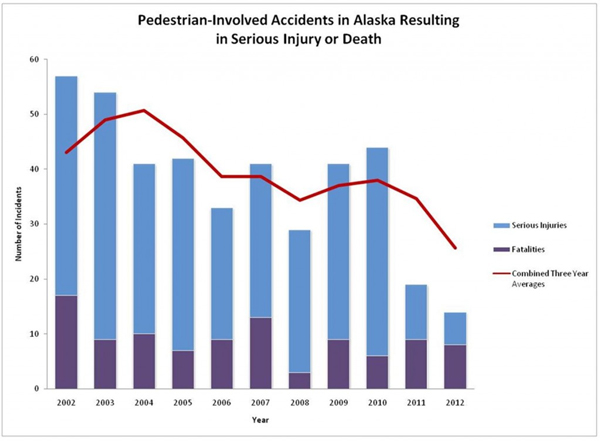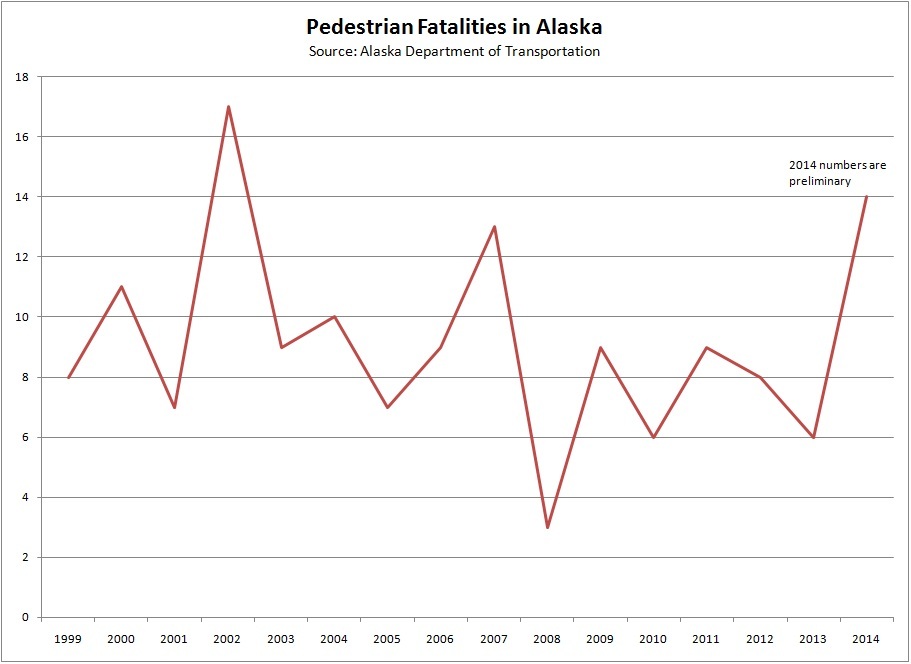
Nearly 8 percent of Alaskans walk to work. It’s the highest rate in the nation according to American Community Survey data. The national average is only 2.8 percent. But the state is also ranked #3 for the rate of pedestrian deaths. Three people have been killed in the past month. So what’s happening in Anchorage to help keep walkers safe?
Dressed in a heavy black jacket and dark pants, Keith Joe walks down Muldoon headed from the bus stop to his trailer as cars rush by. He’s not far from where a pedestrian was killed earlier this month and where he says a friend’s child was killed years before. It’s a trip he makes nearly everyday. He says he only has one major complaint with drivers in the area.
“They just don’t remember to look the other way. They’re just so worried about getting an opening in traffic that they pull out where they block you. They just don’t care. Or sometimes they’ll even see you and they’ll still pull out cause they just want to dive out. I just feel it’s wrong. They’re in a nice warm car and we’re walking and it’s cold. They could wait a second, you know?”
But Joe admits that sometimes he breaks the rules, too. He doesn’t like having trudge up the street to wait at crosswalks for the light to eventually change. He says if traffic flow is low, he’ll cut across the five-lane-wide street, despite the risks.
“Night time is most time we will cross right here.”
“Even though then it’s dark and people can’t see you?” I asked.
“Yeah, well, we can see pretty good…” He shrugs off the question.
State Department of Transportation data shows the number of pedestrian deaths in Alaska jumps erratically from year to year, but the trend is fairly steady– about 9 per year.
DOT Traffic and Safety Engineer Scott Thomas says part of the problem is that pedestrians think they’re visible when they’re not. “You see the headlight on and you say ‘Well, I’m wearing brown.’ But to the motorist that is dark. And it may be competing with the oncoming headlights of other cars.”
Thomas says most pedestrian-vehicle accidents happen in the fall, when it’s dark and roads are starting to get slippery. He says things are usually better in the winter because it’s easier to see people with a white backdrop of snow. But not this year, when the grimy snow isn’t helping visibility.
So there’s recently been a slight spike in pedestrian deaths, but the number of pedestrian accidents that result in serious injury has actually been slowly trending downward since 2000.
Thomas says different design elements help. Crosswalk signals with timers reduce the number of accidents because pedestrians know how long they have to cross the street. He says medians, like the ones that will we built on Muldoon this summer, also help.
“If a pedestrian does try to cross in between an intersection, or in between a signal, then there’s a place of refuge. And it divides the crossing into two steps and makes it easier.”
Anchorage Traffic Engineer Stephanie Mormilo says city code now requires all new road projects to include facilities for walkers and bikers, like sidewalks and bike lanes. She says the municipality is becoming more aware of different needs, mostly in response to community demand.
“I guess there’s a shift in the dynamic, I think. And a lot of people are really recognizing that roads are not just for vehicles. They are not. They are transportation corridors that provide for all users.”
Mormilo says the struggle comes when trying to renovate old roads — they don’t have the right of way to add more sidewalks or bike lanes.
“When you’re reconstructing these existing roads you often have a kind of a set limit, set amount of space of what you really can do when you have all this development surrounding your roads.”
She says they try to use as many innovative designs as possible to incorporate the needs of all types of users. But she says no matter how the road is designed, drivers, walkers, and bicyclists needs to be aware of who is near them to keep everyone safe.
Anne Hillman is the healthy communities editor at Alaska Public Media and a host of Hometown, Alaska. Reach her at ahillman@alaskapublic.org. Read more about Anne here.






